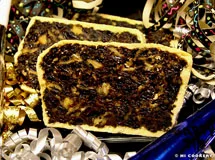The Great Grahams
The Grahams have a rich history and heritage that we are proud to share with the world. Below are articles of interesting people, places and things. Adobe Acrobat Reader is required for the PDF articles. More content will be added gradually to create an archive of resources for the clan.
Dukes of Montrose
Society and Membership
The Clan Graham Society is an organization of the descendants of the families of the “Gallant Grahams” of old Scotland.
Its membership is made up of those Grahams who know and who propagate the very distinguished accomplishments and honorable ideals of the Grahams, past and present. Because of the large number of Grahams in Scotland, their wide dispersion all along the Highland line was from Montrose on the North Sea to Loch Lomond (and further west) down past Glasgow through the Lowlands to Carlisle on the Border.
Other Titled Grahams
Other Famous Grahams
The First Graham of Netherby
PHILADELPHIA, PENNSYLVANIA Lang Will's eldest son, Richard Graham, was the first Graham of Netherby. Who was this Lang Will (William Graham) and what was his title? John [...]
The Grahams: These Are Your People
From the greed of the Campbells, From the ire of the Drummonds, From the pride of the Grahams, From the wind of the Murrays, Good [...]
“Cosmetics tycoon Elizabeth Arden was a Graham” by Shirley Graham Fraser
“Controversial Reverend Sylvester Graham invents the graham cracker” by Jenny Fitzsimmons
“Donald W. Graham adds his ‘magic’ and artistry to Disney’s Magic Kingdom” by Ekena B. Parkinson
Benjamin Graham – “The Father of Security Analysis changed the way investors view and evaluate stocks”
(excerpt from T. Rowe Price Investor, March 2011)
Recipes
The Grahams have great tastes! Whether it’s “gourmet” or clan comfort food, below are some members’ recipes. More will be added soon to build our online clan cookbook. Thanks to HI Cookery for granting the Society permission to use the food photos (other pictures from members are credited). Ith gu leòir! (Scots Gaelic for “Eat plenty!”).

BLACK BUN
Have a Happy Hogmanay with this traditional new year’s cake filled with raisins, currants and almonds. This is a good-luck gift from “the first-footer” (first visitor to one’s home in the new year). Learn more about Scottish new year traditions HERE. And get the recipe with step-by-step photos from the Winter 2012 edition of The Clan Graham News (archived in the Members Only site).

SHORTBREAD
This is the ultimate world-famous cookie from Scotland! Kathleen Wheeless, the Clan Graham Society tent chairperson for the Grandfather Mountain Games in North Carolina, shared her classic shortbread cookie recipe in the Winter 2012 edition of the Clan Graham News. Read more about the cookie’s culinary history and see step-by-step photos for making shortbread in the Members Only site.

MONTROSE TEA CAKES
Although it is not known whether these tasty tea cakes were named after the Scottish town, Montrose, or James Graham the Great Marquis of Montrose, they are still a terrific treat. Click HERE to see the recipe (.jpg/.jpeg file opens in a new browser window).

SCOTCH EGGS
A boiled egg is enrobed in savory sausage, coated in crumbs then deep fried to seal in the flavors. Scotch eggs are a favorite festival food and this substantial snack can be made at home! Click HERE for visual step-by-step photo directions of this recipe.

GRAHAM CRACKERS
Originally named “Dr. Graham’s Honey Biskets,” these crackers were part of Reverend Sylvester Graham‘s controversial diet plan and his specialty graham flour. Learn more about him and get the recipe by downloading the PDF articles HERE (background written by Jenny Fitzsimmons and recipe tested by Ekena B. Parkinson). John and Margaret Graham of North Carolina, who sponsor clan tents in their area, say they bake these treats for the children who come to visit them at the Scottish games. These young “taste testers” give their homemade graham crackers a positive review!

LEEK AND TATTIE SOUP
Leek and tattie (potato) soup is a Scottish staple that is both hearty and heartwarming. The vegetables are cheap and chunky to make a filling first course. The recipe for this comfort cuisine, along with step-by-step photos, is featured in the Winter 2012 edition of The Clan Graham News (log in to the Members Only site).
Significant Places
West Antarctica area named after a Graham
Chieftain Richard Graham was inspired to learn more about Graham Land after his daughter Claire’s father-in-law, who is a bit of a philatelist, came up with the [...]
Graham’s Island (Ferdinandea) named after Sir James Graham
An interesting article about Graham’s land in Antarctica from Richard Graham was published recently. He said that it was named after James Graham who was First Lord [...]
Scots in The South and in Georgia
The remarks below were delivered at the 2002 Annual General Meeting of the Clan Graham Society in Atlanta, Georgia, when the Larry was Vice [...]
General Scottish Roots
The Scottish Thistle
The thistle ranks next to the rose in British heraldic importance. Although of ancient origin, as the rose, the reason for its importance remains largely [...]
Scottish New Year Traditions (Happy Hogmanay!)
The Scottish New Year is known as Hogmanay and both New Year's Eve and New Year's Day were also known as Daft Days. The [...]
Poetry
Music
Click on the links below to see the lyrics and listen to the tunes from an external site.



 His Grace was born on April 6, 1935, in Rhodesia/Zimbabwe, Africa, where his father, then the Marquis of Graham, went to establish his career independent of the social ladder which operated in the United Kingdom at that time. The Marquis and his wife were carving a farm out of the African bush. In an effort to escape the attentions of the mosquitoes, the family’s first home was two round mud huts situated on a kopje. It turned out that the situation was not really suitable for young children. After some illness, the Duke and his sister were returned to Great Britain.
His Grace was born on April 6, 1935, in Rhodesia/Zimbabwe, Africa, where his father, then the Marquis of Graham, went to establish his career independent of the social ladder which operated in the United Kingdom at that time. The Marquis and his wife were carving a farm out of the African bush. In an effort to escape the attentions of the mosquitoes, the family’s first home was two round mud huts situated on a kopje. It turned out that the situation was not really suitable for young children. After some illness, the Duke and his sister were returned to Great Britain.